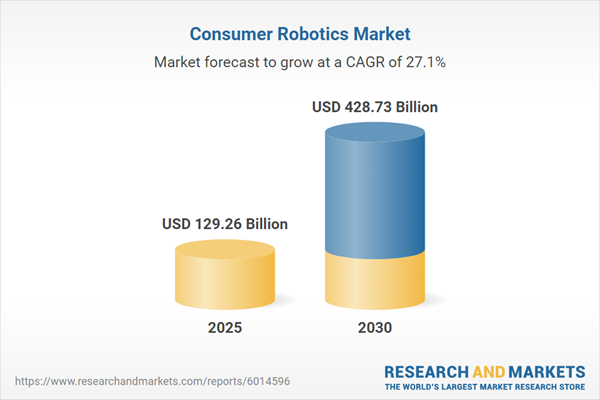Speak directly to the analyst to clarify any post sales queries you may have.
The consumer robotics market is transforming how organizations harness automation, enabling heightened efficiency, adaptive service models, and optimized operations. As decision-makers navigate a shifting technology landscape, strategic investment in robotics is proving essential for competitive resilience and sustained growth.
Market Snapshot: Consumer Robotics Market Size and Outlook
In 2024, the consumer robotics market reached USD 101.49 billion and is projected to reach USD 129.26 billion in 2025. By 2032, forecasts indicate a rise to USD 723.62 billion, representing a compound annual growth rate of 27.83%. This rapid expansion is propelled by innovations in artificial intelligence, advanced hardware, improved sensor capabilities, and greater integration with cloud technologies. Market adoption is growing across various use cases, including process optimization, education, interactive experiences, and healthcare support, driving organizations to adapt their structures and respond effectively to evolving demands.
Scope & Segmentation of the Consumer Robotics Market
This section presents core areas and segments, supporting senior leadership with focused insights into high-value market directions:
- Product Types: Educational robotics, entertainment robots, healthcare assistance devices, cleaning automation, gardening robots, security systems, and advanced vacuum units equip organizations for diverse operational requirements and enhance user experience.
- Applications: Cleaning automation promotes consistency and labor reduction; education technology fosters interactive, STEM-focused learning; interactive services deliver virtual engagement; healthcare support advances remote monitoring; surveillance bolsters safety; and adaptive task management enhances business productivity.
- End Users: Enterprises, educational institutions, healthcare organizations, manufacturers, and residential consumers utilize robotics to boost reliable performance and elevate service standards across varied environments.
- Distribution Channels: Physical retail stores drive engagement through live product demonstrations, while e-commerce strengthens accessibility and informs ongoing market expansion strategies for different customer segments.
- Price Segments: Entry-level models offer accessible automation, mid-range solutions balance cost and performance, and premium products provide advanced capabilities tailored to specialized requirements and higher operational demands.
- Regions: The Americas, Europe, Middle East and Africa, and Asia-Pacific each exhibit unique opportunities shaped by local infrastructure, regulatory factors, and diverse digital transformation journeys.
- Key Technology Players: Companies including iRobot Corporation, Ecovacs Robotics, Roborock Technology, Neato Robotics, Dyson, Samsung Electronics, LG Electronics, Panasonic Corporation, SharkNinja, and Anker Innovations serve as core technology leaders, driving sector standards and shaping the market landscape.
Key Takeaways for Senior Decision-Makers
- Market dynamism enables organizations to introduce agile service and process models, targeting new consumer and enterprise needs.
- Collaborative efforts between robotics providers and software developers enhance systems integration and adaptive automation aligned with business objectives.
- Pursuing sustainable design across the robotics lifecycle increases operational efficiencies and contributes to environmental responsibility goals.
- User-friendly interfaces and adaptive learning technology unlock novel applications, particularly in healthcare and education, widening the spectrum of robotics-driven transformation.
- Diversified distribution through both physical and digital channels allows direct feedback and enables swift adaptation to market shifts and preferences.
- Maintaining compliance with international regulations and executing informed market entry strategies remain essential to mitigate risks in varied regulatory contexts.
Tariff Impact on Global Supply Chains
Recent tariffs on robotics components such as motors and semiconductors are driving a reevaluation of procurement strategies. In response, companies are diversifying supplier bases, turning to regions like Southeast Asia, Mexico, and Eastern Europe to strengthen supply chain resilience and better manage costs. Executives are advised to regularly review and update sourcing, compliance, and risk management frameworks to maintain agility amid ongoing market shifts and regulatory complexity.
Methodology & Data Sources
This report combines comprehensive secondary research with targeted interviews among sector experts across manufacturing, logistics, and end-user domains. A triangulation approach validates the findings, ensuring clarity and practical value for executive decisions regarding consumer robotics implementation.
Why This Report Matters
- Empowers senior leaders to align robotics strategies with broader business transformation and technology integration for maximum operational impact.
- Provides actionable insights to proactively manage risk, adaptability, and regulatory developments as the sector continues to evolve.
- Supports data-driven, scalable planning, optimizing resource allocation and enabling effective automation deployment to strengthen market positioning.
Conclusion
Investing in consumer robotics equips organizations with the flexibility and resilience essential for long-term success as automation reshapes global business environments. Strategic adoption positions enterprises to thrive amid ongoing technological change.
Additional Product Information:
- Purchase of this report includes 1 year online access with quarterly updates.
- This report can be updated on request. Please contact our Customer Experience team using the Ask a Question widget on our website.
Table of Contents
3. Executive Summary
4. Market Overview
7. Cumulative Impact of Artificial Intelligence 2025
Companies Mentioned
The companies profiled in this Consumer Robotics market report include:- iRobot Corporation
- Ecovacs Robotics Co., Ltd.
- Roborock Technology Co., Ltd.
- Neato Robotics, Inc.
- Dyson Ltd.
- Samsung Electronics Co., Ltd.
- LG Electronics Inc.
- Panasonic Corporation
- SharkNinja Operating LLC
- Anker Innovations Ltd.
Table Information
| Report Attribute | Details |
|---|---|
| No. of Pages | 193 |
| Published | October 2025 |
| Forecast Period | 2025 - 2032 |
| Estimated Market Value ( USD | $ 129.26 Billion |
| Forecasted Market Value ( USD | $ 723.62 Billion |
| Compound Annual Growth Rate | 27.8% |
| Regions Covered | Global |
| No. of Companies Mentioned | 11 |









